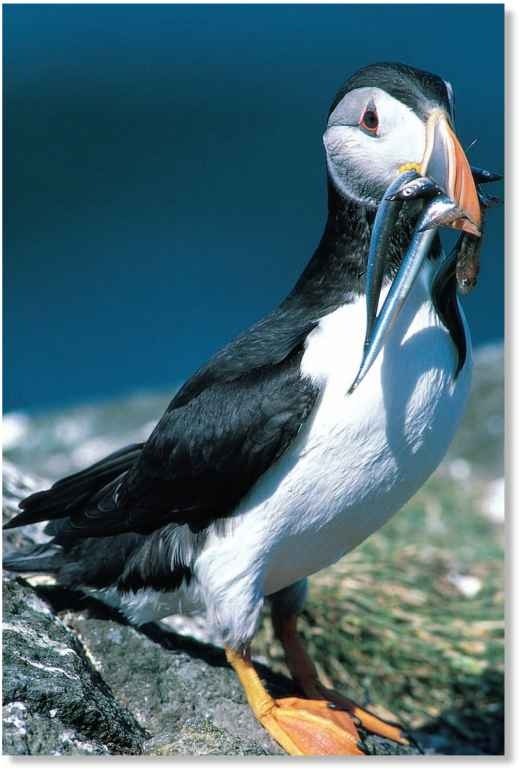ORDER
Charadriiformes
FAMILY
Alcidae
GENUS & SPECIES
KEY FEATURES
• Small, but tough and hardy seabird able to swim and dive for fish on storm-tossed seas
• Nests in vast clifftop or island colonies where pairs occupy a nesting burrow dug into the turf
• Equipped with a massive and colorful bill, which is used for nibbling and wrestling in displays of affection or aggression, and also for catching fish
WHERE IN THE WORLD?
Breeds in the Arctic and along North Atlantic and North Sea coasts, from the northeastern u.S. to northwestern France, Britain, ireland and Scandinavia; moves south into offshore waters in winter

Lifecycle
The Atlantic puffin may seem irresistibly comic with its waddling walk and colorful, oversized bill, but it’s an efficient predator of fish even in rough seas.
HABITAT
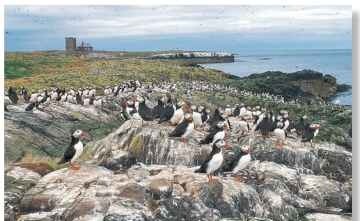
A Island break Puffins breed on rocky, wind-blown coastal islands.
The Atlantic puffin spends most of its life at sea, coming to land only to breed in clifftop or island colonies. In the breeding season,
it occurs on inshore waters from the North Atlantic and North Sea north as far as the High Arctic. But in late summer, puffins drift south away from their colonies, which are deserted by September From fall until early spring, they stray far out to deeper; offshore waters as far south as New Jersey the western coast of Italy and the Canary Islands.
The puffin shares nesting cliffs with other birds of its family Alcidae, but doesn’t compete with them for nest sites as it’s the only one to use burrows high on the cliff. But in the Arctic, frozen ground prevents it from digging burrows, so it must resort to crevices in the cliff faces.
CONSERVATION
Although some of the Atlantic puffin’s colonies, which normally number in the thousands, have declined in size during the 20th century, it remains an abundant species. However, it faces two serious threats — oil pollution in the form of deadly surface slicks and the overfishing of its food supply by large, commercial fishing fleets. On rare occasions, the Atlantic puffin becomes entangled in fishing nets and drowns.
FOOD & HUNTING
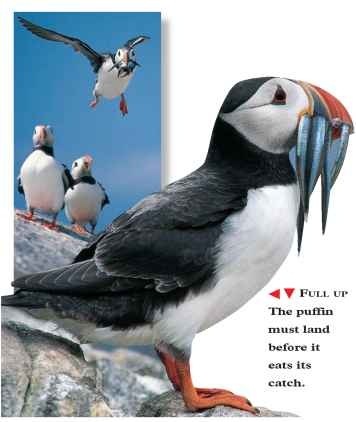
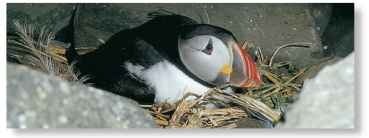
After a display of head-shaking and bill-nibbling, a male and female mate on the surface of the sea not far from their colony Each pair mates for life, returning to the same nesting burrow every year Puffins excavate their burrows, which can be 7′ deep, with their bills, but where possible, simply use an old burrow of another animal.
The female lays her egg in the burrow and both sexes share in incubation, which lasts six weeks. Parents also cooperate in feeding the young, but after 5-7 weeks, they stop bringing food to the nest. Within days, the juvenile leaves, traveling to sea by leaping with fluttering wings as it can’t yet fly with the skill of an adult.
At home on or below the surface of rough and calm seas, the puffin is a master swimmer Diving from the surface, it can cover 150′ horizontally in a single dive for fish. On other occasions, it dips its head under the water while trying to find a shoal of suitable prey.
A relatively limited variety of small marine fish makes up the puffin’s diet, including sand eels, sprats, whitings and rocklings. Most of the fish it catches are less than 4″ long, but fish width is a more important factor: the puffin prefers to feed on prey 1″ thick so that it can line up as many as possible crosswise in its bill. Adult birds, especially in the Arctic, also feed on mollusks and crustaceans, particularly shrimp or planktonlike animals.
Large flocks of circling puffins, known as “wheels,” are a common sight over every colony in the breeding season. But why they do this is unknown.
The Atlantic puffin is still caught for food in Iceland and parts of Scandinavia, where it’s a delicacy.
# Puffins nesting on the edges of a colony tend to be younger, less experienced birds and suffer the greatest losses of eggs and chicks to predators, such as gulls.
The puffin sometimes dives more than 50′ to fish.
BEHAVIOR
Makeshift home If a burrow isn’t available, a puffin nests in a crevice.
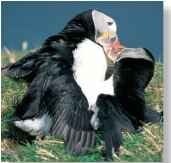
Collection time Puffins gather vegetation for their nest burrows.
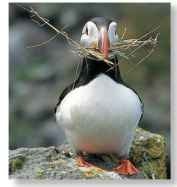
A Living on the edge Puffins have fallen off cliffs when fighting.
TIME FOR DINNER

1 Take-off…
A puffin launches from its high-rise nesting ledge to go fishing.At the colony, there’s a constant stream of birds coming and going.
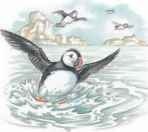
2 Crash landing…
Before splashing down onto the sea, the puffin throws its feet out sideways to provide an airbrake and cushion the impact.
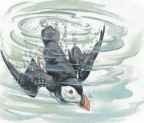
3 Dip down…
Beneath the waves, the puffin swims gracefully, powering through the water using its flipperlike wings and steering with its large feet.
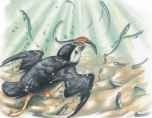
4 Snatch up
Spotting a shoal of sand eels, the puffin gives chase. Its dives are usually a success; it often catches more than one fish at a time.
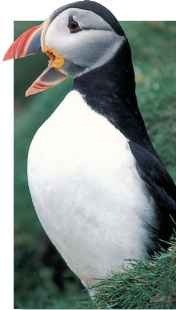
A Growler
The growling call is usually only made on land.
In common with most sociable, colony-nesting birds, the puffin evolved a complex “language” of calls, displays and other body gestures for communication.
At sea, it indicates alarm by bobbing its head up and down; on land, it may growl menacingly When landing at the colony after fishing, or walking through it, the puffin has a submissive pose to avoid fights with other birds. This involves bending its legs while tilting its head upward and raising its wings over its back. Nonetheless, excited squabbles between neighboring pairs are common and two puffins may grapple and twist each other with their bills, while uttering throaty calls, until they eventually pull apart.
Profile
Atlantic Puffin
Even with up to ten fish in its bill, the Atlantic puffin can continue hunting and hold onto its large catch.
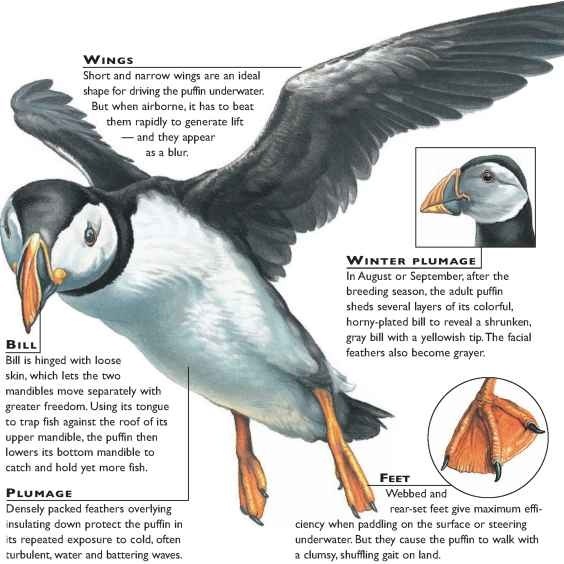
CREATURE COMPARISONS
The tufted puffin (Lunda cirrhata) is one of three puffin species. In the breeding season, it has a pair of pale yellow tufts of feathers, which sprout from behind its eyes and fall over its neck.The rest of its breeding dress is sooty black, except for the cheeks and throat, which are white. In late summer, the puffin loses its colorful tassels and its cheeks become black
A third larger than the Atlantic puffin, the tufted puffin has a bigger red-and-yellow bill. It’s found in the North Pacific, breeding in eastern Siberia and on North America’s western seaboard as far south as California. Like its Atlantic relative, it winters out at sea.
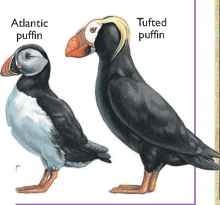
| VITAL STATISTICS |
|
| Weight F |
Male 13-19 oz; female 12—17 oz. |
| ™ Length Head/Body Bill | About 1′ 1 — 1.5″ |
| Wingspan | 1.5—2′ |
| Sexual Maturity | 5—6 years |
| Breeding Season | April—August, depending on latitude |
| Number of Eggs | 1 (rarely 2) |
| Incubation Period | 39—45 days |
| Fledging Period | Variable: 35—50 days |
| Typical Diet | Small fish, with some mollusks and crustaceans (particularly in Arctic waters) |
| Lifespan | 10—15 years |
RELATED SPECIES
• The Atlantic puffin is one of 22 seabird species known as auks; all are in the family Alcidae. Auks are stocky, diving birds in the Northern Hemisphere oceans and include the puffins, auklets, such as the dovekie, Alle alle (below), guillemots, murrelets and the razorbill.

